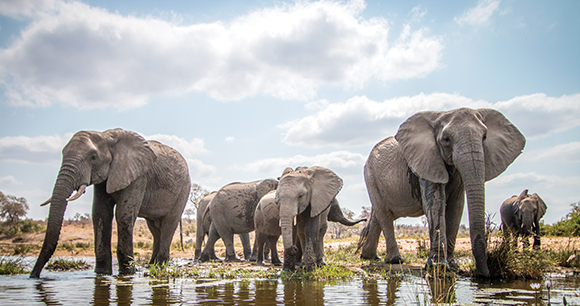Located in upstate New York, Farm Sanctuary’s New York shelter is home to more than 500 rescued animals, including cows, pigs, and chickens. As described in a recent New York Times article—“Why Did the Chicken Cross the Barn? To Sign Up for the Scientific Study.”—some of the sanctuary’s residents also voluntarily participate in behavioral research that aims to better understand the nature and lived experiences of farmed animals as individuals and as species.
Research at Farm Sanctuary follows strict ethics standards, which the sanctuary developed in collaboration with Dr. Lori Gruen, an animal ethicist at Wesleyan University. The guidelines state, among other things, that studies must be noninvasive and benefit the animals, and that sanctuary residents must be viewed as cocreators of knowledge and always be provided with choice and control over their participation in a study. To ensure adherence to these guidelines as well as high levels of scientific rigor, the research is conducted under the guidance of the sanctuary’s Research with the Animals Advisory Committee comprising several scientists and a veterinarian.
Can—and should—all such research with animals be conducted according to similar standards? Advisory committee member Dr. Becca Franks, an assistant professor in the Department of Environmental Studies at New York University, thinks so. Speaking with Dr. Joanna Makowska, AWI’s laboratory animal advisor, Franks explained that noncoercive research with animals as cocreators of knowledge is not only possible, but also exactly the kind of information we need if we want to solve many of the world’s problems, including the biodiversity crisis. “Conducting research this way wouldn’t shut down science,” she explained, “it would be a new way to learn about the world and to understand how our decisions about interventions with wildlife affect biodiversity and conservation.”
Historically, wildlife conservation management grew out of 20th century scientific perspectives that emphasized population- and ecosystem-level patterns and assumed that all individuals of a species behave uniformly, which minimized individual personalities or cultural differences between communities. “When we talk about preserving an elephant or even cod or Atlantic halibut—these are animals who have built up millennia of knowledge. It’s not just a biological inheritance,” said Franks.

Indeed, conservation efforts can sometimes fail because scientists disregard animal psychology. For example, African elephant conservation efforts that focus exclusively on younger individuals’ reproductive potential run the risk of overlooking the important fact that young elephants cannot survive without the information about their social and ecological environment passed on from the matriarchs. Similarly, translocations of kangaroo rats to restored habitats have been shown to be unsuccessful when individual kangaroo rats’ social relationships and preferences are not taken into account. The importance of social groups and intergenerational transfer of knowledge has recently been recognized by the Convention on the Conservation of Migratory Species of Wild Animals, an international treaty operating under the UN Environment Programme.
Franks believes that scientific investigations need to begin with thinking about the inherent worth and value of animals and taking that moral status seriously. “If you have that standard at your core, it steers your attention towards different aspects of the animal’s life and what questions to ask, what problems to solve, and what tools to solve those problems with,” she explained. Traditionally, ethics are seen as a constraint that limits the types of questions you are allowed to ask. However, Franks said, “if you push through that view, and engage with ethics on a level where it is actually changing the way you see the world, it can draw our attention to aspects of the world that we aren’t currently tracking with science very well.” And far from constraining the type of questions science can ask, this type of ethical, collaborative science invites us to consider how different species’ knowledge adds to our limited human perception of the world.
Taking a similar, noncoercive approach to science with animals is Dr. Laurie Santos, professor in the Department of Psychology at Yale University, who conducts much of her research with free-ranging rhesus macaques at Cayo Santiago, a small island off the coast of Puerto Rico. Santos’ area of interest is comparative cognition, which investigates differences in cognitive development and processing between human and nonhuman animals. At Cayo Santiago, monkeys roam, eat, and drink freely among their peers. Far from hindering research, this environment has allowed Santos and colleagues to develop new ways to learn about monkey cognition. Santos uses tasks that capture the monkeys’ attention and for which monkeys volunteer. Actually, Santos’ team uses some of the same methods they use with human infant participants, which has the added—perhaps crucial—advantage of more direct comparisons between the two species.
In a recent review paper, Santos and graduate student Amanda Royka stated that “testing primates in naturalistic conditions allows researchers to study primates’ cognitive abilities under more ecologically valid conditions” and that “more naturalistic contexts may increase subjects’ motivation on tasks, revealing cognitive competencies that may be masked in captive settings.” Echoing this sentiment, Franks firmly believes that traditional science misrepresents animals because it is myopically focused on studying animals living very constrained lives. “There is truth value in telling stories about who animals are and in understanding what we are depriving them of, and how data are distorted, if we constrain them with no choices and few opportunities for pleasure,” she said. “We can’t get the public to care about animals when we provide data on boring and deprived creatures. We need to generate information on rats who are problem solving in their community, looking for the best place to start a family; rats who build elaborate burrows and are interested in burrow maintenance. This is what is taken from them in ‘standard’ cages—reducing their behavioral repertoire and also not telling a more honest story about who they are.”